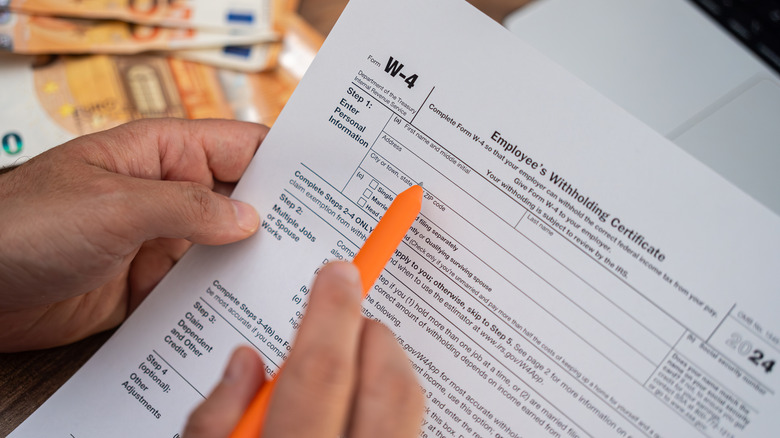If Your Household Tax Refund Is Above This Number, You Beat The National Average
The April 15 conclusion of the 2024 tax season is fast approaching, although serial procrastinators who aren't ready can always file for a six-month extension. If there is one silver lining to the oftentimes arduous task of preparing your tax return, it's that your chances of receiving a refund are pretty good. In fact, a full 64% of filers received a federal tax refund after submitting their 2023 income tax documents. With that in mind, taxpayers might wonder what's considered above or below average when it comes to their federal tax refund amounts.
The average tax refund received for the 2023 tax year was $3,138, according to data from the IRS. That's just slightly less than the average tax refund from the 2022 tax year, which was $3,167. While a surprise influx of money to spend, invest, or even inch your way out of exploding credit card debt is hardly a bad thing, receiving an excessively large tax refund isn't necessarily something to aspire to. After all, a refund is really just a return of your money, which could have instead been accessed throughout the entire prior year.
Don't loan money to the IRS
To understand why a large tax refund isn't a positive event, it helps to understand how refunds are calculated. Every American worker pays a portion of their wages to the federal government to finance essential services and other government activities. For many, an employer automatically deducts these taxes from each paycheck and remits them to the IRS on the employees' behalf. However, self-employed taxpayers — like freelance writers, for example — are required to estimate their annual tax obligation and submit quarterly payments to the IRS towards that amount. Note that remote workers can fall into either category depending on their relationship with their employer(s).
Regardless of whether a taxpayer is a W2 employee or 1099 freelancer, if more taxes were paid over the course of the year than was required by IRS guidelines, the overpayment will be returned to the taxpayer in the form of an income tax refund. However, it's preferable to be accurate in your tax payments throughout the year rather than waiting to collect a large refund at the end. This way, you can have use of those extra funds immediately for paying bills, saving, or investing. Furthermore, the IRS returns any overpayment in the form of a refund, but they don't pay any interest or fees on what's rightfully your money. In essence, grossly overpaying taxes and later receiving a large refund is like giving Uncle Sam a free loan.
Make sure your personal info is accurate
Official employees of a company will complete what's called a W-4 form during the onboarding process. It's this W-4 that the company then uses to determine how much income tax to withhold from each paycheck. Therefore, employees will want to take care that the information on their W-4s is current and accurate. For example, if you get a second job, have children, buy a home, or other important life changes occur, your W-4 should be updated to reflect it.
Freelance workers face a different challenge in that how much they should pay via quarterly installments is actually calculated toward the beginning of each year. If calculated perfectly, a self-employed taxpayer will neither receive a large refund nor owe any money when tax day rolls around. Also, if the income of a freelancer or small business owner significantly increases or decreases over the course of the tax year, adjustments can be made to the quarterly estimated payments in order to avoid under or overpayment. Note that you don't even need to notify the IRS. Simply send a larger or smaller amount. It's important to remember that the average tax refund amount of $3,100 is approximately $250 per month that you could use throughout the course of the year.


